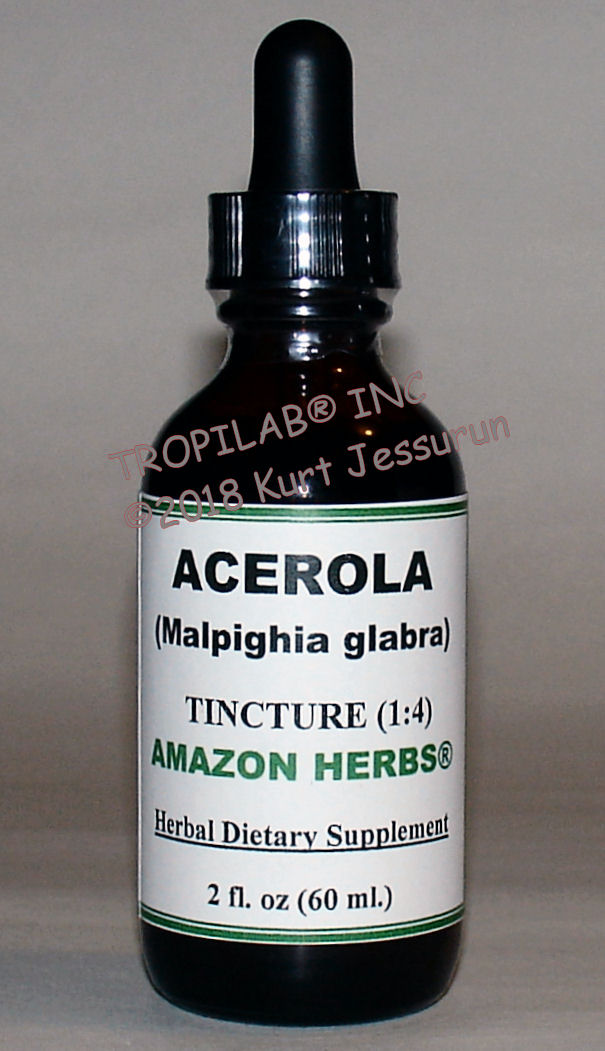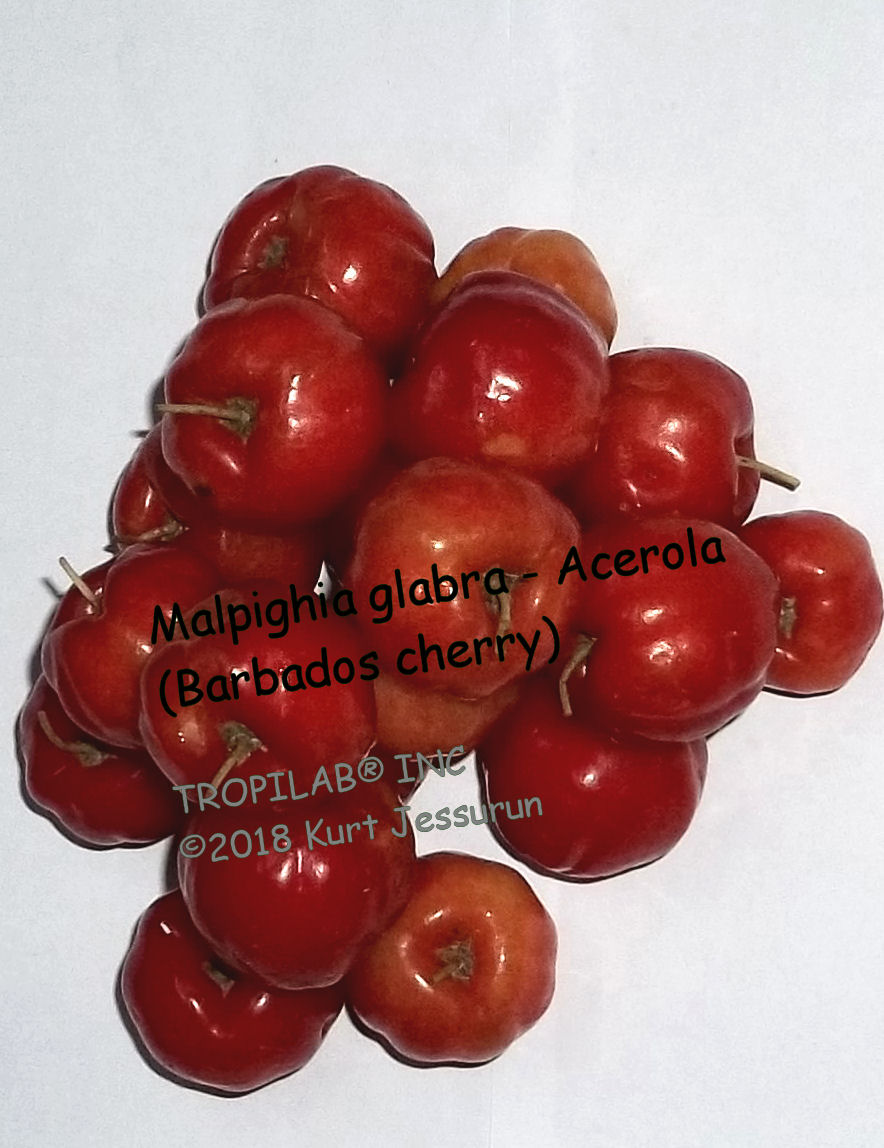 |
 |
|
ACEROLA TINCTURE (tinctura MALPIGHIA GLABRA) from AMAZON HERBS® |

Overview Acerola (Barbados cherry), is indigenous to tropical South- and Central America; it has a very high natural vitamin C content which is a powerful Immune System and Energy Booster. Thereby it helps to prevent and cure colds, flu and other viral and fungal infections. However, there are also many other vitamins antioxidant and nutrients present in the fruit. Since Acerola has excellent antioxidant and antifungal properties, it also helps to boost the immune system and supports the respiratory system. It can reduce low-density lipoprotein (LDL or "bad") cholesterol. Improves physical performance and muscle strength in older people. Acerola has a sweet pleasant taste and is used in Traditional Surinam Medicine against cough, flu, colds, dysentery, diarrhea and liver ailments such as hepatitis. Acerola has a large amount of the complete vitamin C complex. Due to this and along with other phytonutrients such as asphenolic acids, flavonoids, anthocyanins, and carotenoids. It can be regarded as a "super food" (contains large quantities of antioxidants, phytochemicals, vitamins and minerals). Constituents Many phytonutrients such as carotenoids phenolics, anthocyanins, and flavonoids, Vitamin A, vitamin C (ascorbic & dehydroascorbic acids and bioflavonoids) iron, calcium, magnesium, niacin (vitamin B-3), phosphorus, anthocyanins (water-soluble pigments), potassium, riboflavonine (vitamin B-2), thiamine (vitamin B-1), cobalam (vitamin B-12), protein, fiber and zinc. Also present are 3-methyl-3-butenol, dextrose, diketogulonic acid, fructose, furfural, hexadecanoic acid, limonene, l-malic acid and sucrose. The bioflavonoids, such as: quercetin, rutin (formerly known as vitamin P), tyrosinase (organic copper), other trace elements; "K" and "J" factors. Glucose, fructose and some sucrose are the major sugars present in the mature acerola fruit. Pharmacology Acerola (Malpighia glabra L.) has many different therapeutic properties such as immunostimulant, detoxifying due to the very high content of vitamin C in the fruit that stimulates the production of white blood cells (leucocytes). Deficiency of this vitamin results in scurvy (vitamin C deficiency).  The tumor-specific cytotoxic activity and multidrug resistance (MDR) reversal activity of Barbados cherry may suggest its
possible application for cancer therapy.
The tumor-specific cytotoxic activity and multidrug resistance (MDR) reversal activity of Barbados cherry may suggest its
possible application for cancer therapy.Vitamin C, a strong antioxidant, is found in many fruits and vegetables; it may help lower blood pressure; reduces systolic blood pressure (upper value) and diastolic blood pressure (lower value). Regulates the release of sugar in the bloodstream (regulation of insulin and glucose). Vitamin C is an essential coenzyme that is required for normal metabolic function. The vitamin C complex helps to stimulate the production of white blood cells, the front line of defense against viruses and infections. It boosts the immune system, fighting off infections so the body can heal quicker. Research shows that taking vitamin C might shorten the course of the cold or flu drastically. Ripening improved fruit physicochemicals; however, total vitamin C and total soluble phenols contents declined during development, which resulted in a lower total antioxidant activity. Despite this decline, the anthocyanin and yellow flavonoid content increase (cyanidin 3-rhamnoside and quercetin 3-rhamnoside). There are outstanding results for vitamin C, phenols, and antioxidant enzyme activity. Antioxidants used in the food and herbal supplement industry; immature green fruit contains less sugars and would be the best harvest stage for the medicinal purpose side. Vitamin C and quercetin have synergistic effects that make them useful in the prevention and early at-home treatment of COVID-19. An article written by Dr. Paul Marek presents evidence for the use of vitamin C and quercetin based on their biological actions and pharmacokinetics profiles — both as prophylaxis (preserve health) in high-risk populations, and as an adjunct to drugs such as Remdesivir or convalescent plasma in the treatment of hospitalized COVID-19 patients. For the consumer’s market, Acerola (Barbados cherry) fruit should be eaten ripe. Dosage Tincture (from the fruit): 1 - 3 ml (1 -3 full droppers) daily. For more information on Acerola, go to the BARBADOS CHERRY page. Reference Antioxidant Metabolism during Fruit Development of Different Acerola (Malpighia emarginata D.C) Clones. Luciana De Siqueira Oliveira†, Carlos Farley Herbster Moura§, Edy Sousa De Brito§, Rosa Virgínia Soares Mamede§, and Maria Raquel Alcântara De Miranda*† Biological activity of Barbados cherry (Acerola fruit) extracts and fractions. Motohashi N, Wakabayashi H, Kurihara T, Fukushima H, Yamada T, Kawase M, Sohara Y, Tani S, Shirataki Y, Sakagami H, Satoh K, Nakashima H, Molnár A, Spengler G, Gyémánt N, Ugocsai K, Molnár J. Evaluation of the Content of Vitamin C in Malpighia glabra L. (Acerola) Center for Pharmaceutical Research and Drug Development (CIDEM). Ave. 26 # 1605 e/ Boyeros y Puentes Grandes. Havana, Cuba. García CM, Martínez V, García L, Nogueira A, González ML, Rivera MM, Sánchez P, Rodríguez C, Díaz M. Quercetin and Vitamin C: An Experimental, Synergistic Therapy for the Prevention and Treatment of SARS-CoV-2 Related Disease (COVID-19) Dr Marek June 19, 2020, journal "Frontiers in Immunology" Quercetin and Vitamin C: Synergistic Therapy for COVID-19 Analysis by Dr. Joseph Mercola. Fact Checked The above presentation is for informational and educational purposes only. It is based on scientific studies (human, animal, or in vitro), clinical experience, or traditional usage. For many of the conditions discussed, treatment with prescribed (RX) or over - the - counter medication (OTC) is also available. Consult your doctor, practitioner, and/or pharmacist for any health problem and before using dietary supplements or before making any changes in prescribed medications. |
|
For the right freight rate, shipping charges, conditions and delivery service, please visit our Webstore page! |
|
TROPILAB® INC copyright disclaimer |